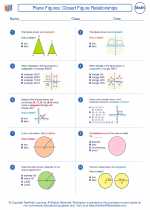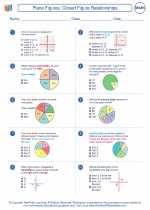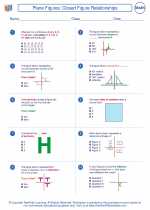Plane Figures: Closed Figure Relationships -> coordinate plane
Coordinate Plane Study Guide
A coordinate plane is a two-dimensional plane formed by two number lines, known as the x-axis and y-axis, that intersect at a right angle at a point called the origin. The coordinate plane is used to locate points and graph lines and shapes.
Key Concepts
1. X-Axis: The horizontal number line on the coordinate plane. Positive numbers are to the right of the origin, and negative numbers are to the left.
2. Y-Axis: The vertical number line on the coordinate plane. Positive numbers are above the origin, and negative numbers are below.
3. Origin: The point where the x-axis and y-axis intersect, denoted as (0, 0).
4. Coordinates: Points on the coordinate plane are written as (x, y), where x represents the horizontal position along the x-axis and y represents the vertical position along the y-axis.
Graphing Points
To graph a point (x, y) on the coordinate plane, start at the origin and move x units to the right if x is positive or to the left if x is negative. Then move y units up if y is positive or down if y is negative.
Quadrants
The coordinate plane is divided into four quadrants by the x-axis and y-axis. The quadrants are numbered counterclockwise starting from the top right quadrant as Quadrant I, and proceeding to Quadrant II, Quadrant III, and Quadrant IV.
Practice Questions
1. Plot the point (3, 4) on the coordinate plane.
2. Identify the quadrant in which the point (-2, -5) lies.
3. Find the coordinates of the point in Quadrant III that is 2 units to the left of the origin and 3 units below the x-axis.
[Coordinate Plane] Related Worksheets and Study Guides:
.◂Math Worksheets and Study Guides Seventh Grade. Plane Figures: Closed Figure Relationships

 Worksheet/Answer key
Worksheet/Answer key
 Worksheet/Answer key
Worksheet/Answer key
 Worksheet/Answer key
Worksheet/Answer key
